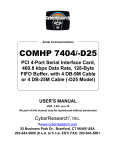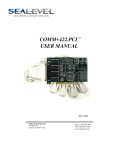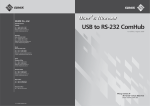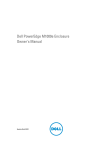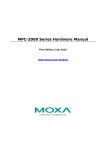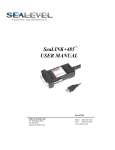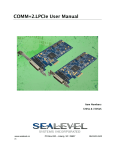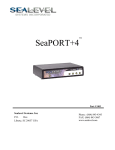Download Black Box RS-232/422/485 User's Manual
Transcript
JULY 2002 IC1020A IC1021A IC1022A Dual-Port USB Hub—RS-232/422/485 Quad-Port USB Hub—RS-422/485 Quad-Port USB Hub—RS-232/422/485 CUSTOMER SUPPORT INFORMATION Order toll-free in the U.S.: Call 877-877-BBOX (outside U.S. call 724-746-5500) FREE technical support 24 hours a day, 7 days a week: Call 724-746-5500 or fax 724-746-0746 Mailing address: Black Box Corporation, 1000 Park Drive, Lawrence, PA 15055-1018 Web site: www.blackbox.com • E-mail: [email protected] FCC AND IC RFI STATEMENTS FEDERAL COMMUNICATIONS COMMISSION and INDUSTRY CANADA RADIO FREQUENCY INTERFERENCE STATEMENTS Class B Digital Device. This equipment has been tested and found to comply with the limits for a Class B computing device pursuant to Part 15 of the FCC Rules. These limits are designed to provide reasonable protection against harmful interference in a residential installation. However, there is no guarantee that interference will not occur in a particular installation. This equipment generates, uses, and can radiate radio frequency energy, and, if not installed and used in accordance with the instructions, may cause harmful interference to radio communications. If this equipment does cause harmful interference to radio or telephone reception, which can be determined by turning the equipment off and on, the user is encouraged to try to correct the interference by one of the following measures: • Reorient or relocate the receiving antenna. • Increase the separation between the equipment and receiver. • Connect the equipment into an outlet on a circuit different from that to which the receiver is connected. • Consult an experienced radio/TV technician for help. Caution Changes or modifications not expressly approved by the party responsible for compliance could void the user’s authority to operate the equipment. To meet FCC requirements, shielded cables and power cords are required to connect this device to a personal computer or other Class B certified device. This digital apparatus does not exceed the Class B limits for radio noise emission from digital apparatus set out in the Radio Interference Regulation of Industry Canada. Le présent appareil numérique n’émet pas de bruits radioélectriques dépassant les limites applicables aux appareils numériques de classe B prescrites dans le Règlement sur le brouillage radioélectrique publié par Industrie Canada. 1 DUAL- AND QUAD-PORT USB HUBS EMC Directive Statement Products bearing the CE Label fulfill the requirements of the EMC directive (89/336/EEC) and of the low-voltage directive (73/23/EEC) issued by the European Commission. To obey these directives, the following European standards must be met: • EN55022 Class B—Limits and methods of measurement of radio interference characteristics of information technology equipment. • EN55024—Information technology equipment immunity characteristics limits and methods of measurements. • EN60950 (IEC950)—Safety of information technology equipment, including electrical business equipment. Always use the cabling provided with this product if possible. If no cable is provided or if an alternate cable is required, use high-quality shielded cabling to maintain compliance with EMC directives. 2 NOM STATEMENT NORMAS OFICIALES MEXICANAS (NOM) ELECTRICAL SAFETY STATEMENT INSTRUCCIONES DE SEGURIDAD 1. Todas las instrucciones de seguridad y operación deberán ser leídas antes de que el aparato eléctrico sea operado. 2. Las instrucciones de seguridad y operación deberán ser guardadas para referencia futura. 3. Todas las advertencias en el aparato eléctrico y en sus instrucciones de operación deben ser respetadas. 4. Todas las instrucciones de operación y uso deben ser seguidas. 5. El aparato eléctrico no deberá ser usado cerca del agua—por ejemplo, cerca de la tina de baño, lavabo, sótano mojado o cerca de una alberca, etc.. 6. El aparato eléctrico debe ser usado únicamente con carritos o pedestales que sean recomendados por el fabricante. 7. El aparato eléctrico debe ser montado a la pared o al techo sólo como sea recomendado por el fabricante. 8. Servicio—El usuario no debe intentar dar servicio al equipo eléctrico más allá a lo descrito en las instrucciones de operación. Todo otro servicio deberá ser referido a personal de servicio calificado. 9. El aparato eléctrico debe ser situado de tal manera que su posición no interfiera su uso. La colocación del aparato eléctrico sobre una cama, sofá, alfombra o superficie similar puede bloquea la ventilación, no se debe colocar en libreros o gabinetes que impidan el flujo de aire por los orificios de ventilación. 10. El equipo eléctrico deber ser situado fuera del alcance de fuentes de calor como radiadores, registros de calor, estufas u otros aparatos (incluyendo amplificadores) que producen calor. 11. El aparato eléctrico deberá ser connectado a una fuente de poder sólo del tipo descrito en el instructivo de operación, o como se indique en el aparato. 3 DUAL- AND QUAD-PORT USB HUBS 12. Precaución debe ser tomada de tal manera que la tierra fisica y la polarización del equipo no sea eliminada. 13. Los cables de la fuente de poder deben ser guiados de tal manera que no sean pisados ni pellizcados por objetos colocados sobre o contra ellos, poniendo particular atención a los contactos y receptáculos donde salen del aparato. 14. El equipo eléctrico debe ser limpiado únicamente de acuerdo a las recomendaciones del fabricante. 15. En caso de existir, una antena externa deberá ser localizada lejos de las lineas de energia. 16. El cable de corriente deberá ser desconectado del cuando el equipo no sea usado por un largo periodo de tiempo. 17. Cuidado debe ser tomado de tal manera que objectos liquidos no sean derramados sobre la cubierta u orificios de ventilación. 18. Servicio por personal calificado deberá ser provisto cuando: A: El cable de poder o el contacto ha sido dañado; u B: Objectos han caído o líquido ha sido derramado dentro del aparato; o C: El aparato ha sido expuesto a la lluvia; o D: El aparato parece no operar normalmente o muestra un cambio en su desempeño; o E: El aparato ha sido tirado o su cubierta ha sido dañada. 4 TRADEMARKS TRADEMARKS USED IN THIS MANUAL AT, IBM, and PS/2 are registered trademarks of International Business Machines Corporation. Windows is a registered trademark of Microsoft Corporation. Any other trademarks mentioned in this manual are acknowledged to be the property of the trademark owners. 5 DUAL- AND QUAD-PORT USB HUBS Contents Chapter Page 1. Specifications . . . . . . . . . . . . . . . . . . . . . . . . . . . . . . . . . . . . . . . . . . . . . . . . . . 7 2. Introduction . . . . . . . . . . . . . . . . . . . . . . . . . . . . . . . . . . . . . . . . . . . . . . . . . . . 8 2.1 Overview . . . . . . . . . . . . . . . . . . . . . . . . . . . . . . . . . . . . . . . . . . . . . . . . . . 8 2.2 What’s Included . . . . . . . . . . . . . . . . . . . . . . . . . . . . . . . . . . . . . . . . . . . . 8 2.3 Technical Description . . . . . . . . . . . . . . . . . . . . . . . . . . . . . . . . . . . . . . . 8 2.4 Connector Pin Assignments. . . . . . . . . . . . . . . . . . . . . . . . . . . . . . . . . . . 9 3. Installation . . . . . . . . . . . . . . . . . . . . . . . . . . . . . . . . . . . . . . . . . . . . . . . . . . . 10 3.1 Operating System Installation . . . . . . . . . . . . . . . . . . . . . . . . . . . . . . . . 10 3.2 System Installation . . . . . . . . . . . . . . . . . . . . . . . . . . . . . . . . . . . . . . . . . 10 4. Configuration . . . . . . . . . . . . . . . . . . . . . . . . . . . . . . . . . . . . . . . . . . . . . . . . . 12 4.1 Original Configuration . . . . . . . . . . . . . . . . . . . . . . . . . . . . . . . . . . . . . 12 4.2 Electrical Interface Selection. . . . . . . . . . . . . . . . . . . . . . . . . . . . . . . . . 12 4.2.1 Dual-Port USB Hub—RS-232/422/485 (IC1020A). . . . . . . . . . 12 4.2.2 Quad-Port USB Hub—RS-422/485 (IC1021A) . . . . . . . . . . . . . 15 4.2.3 Quad-Port USB Hub—RS-232/422/485 (IC1022A) . . . . . . . . . 17 Appendix A. Troubleshooting . . . . . . . . . . . . . . . . . . . . . . . . . . . . . . . . . . . . . . . 22 A.1 Troubleshooting Tips. . . . . . . . . . . . . . . . . . . . . . . . . . . . . . . . . . . . . . . 22 A.2 Calling Black Box . . . . . . . . . . . . . . . . . . . . . . . . . . . . . . . . . . . . . . . . . . 23 A.3 Shipping and Packaging . . . . . . . . . . . . . . . . . . . . . . . . . . . . . . . . . . . . 23 Appendix B. Electrical Interfaces. . . . . . . . . . . . . . . . . . . . . . . . . . . . . . . . . . . . . 24 B.1 RS-232 . . . . . . . . . . . . . . . . . . . . . . . . . . . . . . . . . . . . . . . . . . . . . . . . . . . 24 B.2 RS-422 . . . . . . . . . . . . . . . . . . . . . . . . . . . . . . . . . . . . . . . . . . . . . . . . . . . 24 B.3 RS-485 . . . . . . . . . . . . . . . . . . . . . . . . . . . . . . . . . . . . . . . . . . . . . . . . . . . 25 Appendix C. Asynchronous Communication . . . . . . . . . . . . . . . . . . . . . . . . . . . 26 6 CHAPTER 1: Specifications 1. Specifications Standards: USB version 1.1 Speed: RS-232: Up to 460.8 kbps; RS-422/485: Up to 921.6 kbps Indicators: IC1020A: (5) Status LEDs: (3) USB Enabled; (2) Port Activity; IC1021A, IC1022A: (9) Status LEDs: (5) USB Enabled; (4) Port Activity Connectors: IC1020A: (1) USB Type B; (2) DB9 male; IC1021A, IC1022A: (1) USB Type B, (4) DB9 male Temperature Tolerance: Operating: 32 to 122°F (0 to 50°C); Storage: -4 to +158F (-20 to +70°C) Relative Humidity: 10 to 90% noncondensing Mean Time Between Failures (MTBF): Greater than 150,000 hours (calculated) Power: 500 mA per port supplied from the USB root hub or a self-powered hub Size: 1.5"H x 5.3"W x 7.1"H (3.8 x 13.5 x 18 cm) Weight: 1 lb. (0.5 kg) 7 DUAL- AND QUAD-PORT USB HUBS 2. Introduction 2.1 Overview The USB Hub equips the PC with 2 or 4 USB to RS-232/422/485 or RS-422/485 asynchronous serial ports. It gives you a versatile interface for common serial needs. Three models are available: • The Dual-Port USB Hub (IC1020A) has 2 USB ports to RS-232/422/485 serial ports. • The Quad-Port USB Hub (IC1021A) has 4 USB ports to RS-422/485 serial ports. • The Quad-Port USB Hub (IC1022A) has 4 USB ports to RS-232/422/485 serial ports. Unlike more traditional products, the USB Hub does not require opening the computer case, nor does it require resources such as I/O ports or IRQs. It does require a system that supports USB both in terms of hardware and operating system. 2.2 What’s Included The USB Hub is shipped with the following items. • (1) Dual-Port USB Hub RS-232/422/485, Quad-Port USB Hub RS-422/485, or Quad-Port USB Hub RS-232/422/485. • (1) USB cable for connecting to the upstream host/hub. • (1) CD-ROM disk containing drivers and installation software. • This users’ manual. If anything is missing or damaged, contact Black Box at 724-746-5500. 2.3 Technical Description The Dual-Port USB Hub (IC1020A) uses two chips. The Quad-Port USB Hubs (IC1021A and IC1022A) use four chips. These chips feature programmable baud rate, data format, 128-byte dual-port TX buffer, and 384-byte dual-port RX buffer. The RS-232/422/485 and the RS-422/485 transceivers support data rates up to 921.6 kbps for RS-422/485 and 460.8 kbps for RS-232. 8 CHAPTER 2: Introduction 2.4 Connector Pin Assignments The IC1020A has one USB Type B connector and two DB9 male connectors. The IC1021A and IC1022A have one USB Type B connector and four DB9 male connectors. The pinouts for the DB9 connectors are described in Tables 2-1 and 2-2. Table 2-1. RS-422/485 DB9 male connector pin assignments. Signal Name Pin # Mode RX+ RXTXTX + GND RTS+ RTSCTSCTS+ Receive Data Positive Receive Data Negative Transmit Data Negative Transmit Data Positive Ground Request To Send Positive Request To Send Negative Clear To Send Negative Clear To Send Positive 1 2 3 4 5 6 7 8 9 Input Input Output Output — Output Output Input Input Table 2-2. RS-232 DB9 male connector pin assignments. Signal Name Pin # Mode DCD RX TX DTR GND DSR RTS CTS RI Data Carrier Detect Receive Data Transmit Data Data Terminal Ready Ground Data Set Ready Request To Send Clear To Send Ring Indicator 1 2 3 4 5 6 7 8 9 Input Input Output Output — Input Output Input Input 9 DUAL- AND QUAD-PORT USB HUBS 3. Installation 3.1 Operating System Installation Choose Install Software at the beginning of the CD and follow the prompts to install SeaCOM. 3.2 System Installation The screen capture shown in Figure 3-1 is taken from a Windows® 98 installation. Your particular operating system may differ slightly from what is shown, based on your version of Windows. The USB Hub can be connected to any upstream type A port either at the PC host or an upstream hub. The USB Hub is hot pluggable, meaning that you don’t have to power down your computer before installation. Connect the USB Hub to an upstream host or hub. The New Hardware Found wizard will now locate the appropriate drivers. These drivers were installed during the software setup procedure. Once the drivers are found, a new window will pop up indicating the installation of each of the four new ports. If you view the Device Manager, you should have new COM ports in the Ports (COM & LPT) device class; this is shown in Figure 3-1. 10 CHAPTER 3: Installation Figure 3-1. System Properties screen, Device Manager tab. You can access your new COM ports by using the assigned COM identifiers as shown in Figure 3-1. In this case, it is COM3, 4, 5, and 6. However, this assignment will vary from system to system. At this point, the hardware is recognized and ready to use. 11 DUAL- AND QUAD-PORT USB HUBS 4. Configuration 4.1 Original Configuration This device ships with the following configuration: • 422 mode, • 120 ohm termination, • 1 K-ohm pull-up resistance on RX+, and • 1 K-ohm pull-down resistance on RX-. To change this configuration, you must open the box. Do this by removing the four screws located on the bottom. When reassembling, please note that the top and bottom are keyed to fit in only one direction. 4.2 Electrical Interface Selection Each of the two DB9 ports on the IC1020A can be individually configured as an RS-232, RS-422 (2-wire operation), or RS-485 (2- or 4-wire operation) interface. Each of the four DB9 ports on the IC1021A is configured as RS-422 or RS-485. Each of the four DB9 ports on the IC1022A can be configured as RS-232, RS-422, or RS-485. This is selectable via the DIP switches and jumper shunts. The switch and jumper positions are described in Sections 4.2.1 through 4.2.3. 4.2.1 DUAL-PORT USB HUB—RS-232/422/485 (IC1020A) You have a variety of configuration options for the two DB9 ports on the Dual-Port USB Hub. You can set both ports as RS-232, both ports as RS-422, both ports as RS-485, or any combination of these interfaces. You also need to select termination (ON or OFF) for each port, and pull-up and pull-down resistors (ON or OFF) for each port. When selecting a configuration for your Hub, refer to Tables 4-1 through 4-3 and Figures 4-1 and 4-2. Jumpers E5, E6, E7, and E8 To configure Port 1 on the Dual-Port USB Hub for RS-232, select Jumper E8 on the circuit board. To configure Port 2 for RS-232, select Jumper E5. (See Table 4-1.) You do not need to set any DIP switches to configure Port 1 or 2 for RS-232. 12 CHAPTER 4: Configuration Table 4-1. Jumper settings. Jumper Port RS-232 E5 E6 E7 E8 2 2 1 1 X RS-422/485 X X X Switch SW4 Settings To configure the ports on the Dual-Port USB Hub for RS-422/RS-485 instead of RS-232, select Jumper E7 for Port 1 and Jumper E6 for Port 2. (See Table 4-1.) When you are running RS-422 or RS-485, you also need to set switch SW4, positions 1 through 10 (see Figure 4-1 and Table 4-2). For example, to set RS-485 2-wire operation on Port 1, set SW4-1 and 4-2 to ON. For RS-485 4-wire operation, regardless of the interface, SW4-3 and SW4-8 are always set to ON. Pull-down resistor (PD) for Port 1 (SW4-4) and pull-up resistor (PU) for Port 1 (SW4-5) can also be set to ON or OFF for RS-422 or RS-485. Pull-down resistor (PD) for Port 2 (SW4-9) and pull-up resistor (PU) for Port 2 (SW4-10) can also be set to ON or OFF for RS-422 or RS-485 operation. Figure 4-1. Switch SW4. NOTE Switch positions SW4-1, 2, 3, 4, and 5 are for Port 1. Switch positions SW4-6, 7, 8, 9, and 10 are for Port 2. 13 DUAL- AND QUAD-PORT USB HUBS Table 4-2. DIP-switch SW4 settings. Switch Setting Switch Number Port Description RS-485 RS-422 L L T PD PU L L T PD PU SW4-1 SW4-2 SW4-3 SW4-4 SW4-5 SW4-6 SW4-7 SW4-8 SW4-9 SW4-10 1 1 1 1 1 2 2 2 2 2 TX+ to RX+ TX- to RXTermination 1K Pull-Down 1K Pull-Up TX+ to RX+ TX- to RXTermination 1K Pull-Down 1K Pull-Up ON ON ON ON ON ON ON ON ON ON OFF OFF ON OFF OFF OFF OFF ON OFF OFF L = Loops TX+ to RX+ or RX- to TX- for two-wire operation. T = Adds a 120-ohm termination resistor between RX+ and RX-. PU = Pull-up. Adds a 1 K-ohm pull-up resistor to RX+. PD = Pull-down. Adds a 1 K-ohm pull-down resistor to RX-. Switch SW3 Settings To select RS-485 mode (4-wire or 2-wire operation) or RS-422 mode (4-wire operation), set the DIP switch labeled SW3 on the circuit board. (See Figure 4-2 and Table 4-3.) Figure 4-2. RS-422/485 interface configuration. NOTE Switch positions SW3-1 and SW3-2 are for Port 1 and switch positions SW3-3 and SW3-4 are for Port 2. 14 CHAPTER 4: Configuration Table 4-3. DIP-switch SW3 settings. Switch Setting Switch Port Number Description RS-485 RS-422 485 NE 485 NE SW3-1 SW3-2 SW3-3 SW3-4 485 Mode (4-wire) 485 Mode, No Echo (2-wire) 485 Mode (4-wire) 485 Mode, No Echo (2-wire) ON ON ON ON OFF OFF OFF OFF 1 1 2 2 NE = No Echo. In a two-wire setup, the receiver will not echo back the transmitted data. 4.2.2 QUAD-PORT USB HUB—RS-422/485 (IC1021A) Each of the four DB9 ports on the Quad-Port USB Hub can be set as either RS-422 or RS-485. You do not need to set a jumper to select these options. Instead, you just need to set DIP-switches SW1, SW2, SW3, and SW4. Switch SW2 and SW4 Settings To select either RS-422 or RS-485, set the DIP switches labeled SW2 and SW4 on the circuit board (see Figure 4-3). Table 4-4 lists the possible settings for DIPswitches SW2 and SW4. You can also set termination, pull-up resistance, and pulldown resistance via these switches. Figure 4-3. Switches SW2 and SW4. NOTE Switch positions SW4-1, 2, 3, 4, and 5 are for Port 1. Switch positions SW4-6, 7, 8, 9, and 10 are for Port 2. Switch positions SW2-1, 2, 3, 4, and 5 are for Port 3. Switch positions SW2-6, 7, 8, 9, and 10 are for Port 4. 15 DUAL- AND QUAD-PORT USB HUBS Table 4-4. DIP-switches SW2 and SW4 settings. Switch Setting Switch Number Port Description RS-485 RS-422 L L T PD PU L L T PD PU L L T PD PU L L T PD PU SW2-1 SW2-2 SW2-3 SW2-4 SW2-5 SW2-6 SW2-7 SW2-8 SW2-9 SW2-10 SW4-1 SW4-2 SW4-3 SW4-4 SW4-5 SW4-6 SW4-7 SW4-8 SW4-9 SW4-10 3 3 3 3 3 4 4 4 4 4 1 1 1 1 1 2 2 2 2 2 TX+ to RX+ TX- to RXTermination 1K Pull-Down 1K Pull-Up TX+ to RX+ TX- to RXTermination 1K Pull-Down 1K Pull-Up TX+ to RX+ TX- to RXTermination 1K Pull-Down 1K Pull-Up TX+ to RX+ TX- to RXTermination 1K Pull-Down 1K Pull-Up ON ON ON ON ON ON ON ON ON ON ON ON ON ON ON ON ON ON ON ON OFF OFF ON OFF OFF OFF OFF ON OFF OFF OFF OFF ON OFF OFF OFF OFF ON OFF OFF L = Loops TX+ to RX+ for two-wire operation. T = Adds a 120-ohm termination resistor between RX+ and RX-. PU = Pull-up. Adds a 1 K-ohm pull-up resistor to RX+. PD = Pull-down. Adds a 1 K-ohm pull-down resistor to RX-. Switch SW1 and SW3 Settings To select RS-485 mode (4-wire or 2-wire operation) or RS-422 mode (4-wire operation), set the DIP switches labeled SW1 and SW3 on the circuit board. (See Figure 4-4 and Table 4-5.) 16 CHAPTER 4: Configuration Figure 4-4. RS-422/485 interface configuration. NOTE Switch positions SW3-1 and 2 are for Port 1, SW3-3 and 4 are for Port 2, SW1-1 and 2 are for Port 3, and SW1-3 and 4 are for Port 4. Table 4-5. DIP-switch SW1 and SW3 settings. Switch Setting Switch Port Number Description RS-485 RS-422 485 NE 485 NE 485 NE 485 NE SW1-1 SW1-2 SW1-3 SW1-4 SW3-1 SW3-2 SW3-3 SW3-4 485 Mode (4-wire) 485 Mode, No Echo (2-wire) 485 Mode (4-wire) 485 Mode, No Echo (2-wire) 485 Mode (4-wire) 485 Mode, No Echo (2-wire) 485 Mode (4-wire) 485 Mode, No Echo (2-wire) ON ON ON ON ON ON ON ON OFF OFF OFF OFF OFF OFF OFF OFF 3 3 4 4 1 1 2 2 NE = No Echo. In a two-wire setup, the receiver will echo back all transmitted data. 4.2.3 QUAD-PORT USB HUB—RS-232/422/485 (IC1022A) You have a variety of configuration options for the four DB9 ports on the QuadPort USB Hub. You can set all ports as RS-232, all ports as RS-422, all ports as RS485, or any combination of these interfaces. You also need to select termination (ON or OFF) for each port, and pull-up and pull-down resistors (ON or OFF) for 17 DUAL- AND QUAD-PORT USB HUBS each port. When selecting a configuration for your Hub, refer to Tables 4-6 through 4-8 and Figures 4-5 and 4-6. Jumpers E1, E2, E3, E4, E5, E6, E7, and E8 To configure Port 1 on the Quad-Port USB Hub for RS-232, select Jumper E8 on the circuit board. To configure Port 2 for RS-232, select Jumper E5. To configure Port 3 for RS-232, select Jumper E4, and for Port 4, select Jumper E1. (See Table 4-6 for all the jumper settings.) Table 4-6. Jumper settings. Jumper Port RS-232 E1 E2 E3 E4 E5 E6 E7 E8 4 4 3 3 2 2 1 1 X RS-422/485 X X X X X X X Switch SW2 and SW4 Settings To select RS-485 mode (4-wire or 2-wire operation) or RS-422 mode (4-wire operation), as well as termination, pull-up resistance, and pull-down resistance, set the DIP switches labeled SW2 and SW4 on the circuit board. (See Figure 4-5 and Table 4-7.) 18 CHAPTER 4: Configuration Figure 4-5. Switches SW2 and SW4. NOTE Switch positions SW4-1, 2, 3, 4, and 5 are for Port 1. Switch positions SW4-6, 7, 8, 9, and 10 are for Port 2. Switch positions SW2-1, 2, 3, 4, and 5 are for Port 3. Switch positions SW2-6, 7, 8, 9, and 10 are for Port 4. Table 4-7. DIP-switches SW2 and SW4 settings. Switch Setting Switch Number Port Description RS-485 RS-422 L L T PD PU L L T PD PU L L T PD PU L L T SW2-1 SW2-2 SW2-3 SW2-4 SW2-5 SW2-6 SW2-7 SW2-8 SW2-9 SW2-10 SW4-1 SW4-2 SW4-3 SW4-4 SW4-5 SW4-6 SW4-7 SW4-8 3 3 3 3 3 4 4 4 4 4 1 1 1 1 1 2 2 2 TX+ to RX+ TX- to RXTermination 1K Pull-Down 1K Pull-Up TX+ to RX+ TX- to RXTermination 1K Pull-Down 1K Pull-Up TX+ to RX+ TX- to RXTermination 1K Pull-Down 1K Pull-Up TX+ to RX+ TX- to RXTermination ON ON ON ON ON ON ON ON ON ON ON ON ON ON ON ON ON ON OFF OFF ON OFF OFF OFF OFF ON OFF OFF OFF OFF ON OFF OFF OFF OFF ON 19 DUAL- AND QUAD-PORT USB HUBS Table 4-7 (continued). DIP-switches SW2 and SW4 settings. Switch Setting Switch Number Port Description RS-485 RS-422 PD PU SW4-9 SW4-10 2 2 1K Pull-Down 1K Pull-Up ON ON OFF OFF L = Loops TX+ to RX+ for two-wire operation. T = Adds a 120-ohm termination resistor between RX+ and RX-. PU = Pull-up. Adds a 1 K-ohm pull-up resistor to RX+. PD = Pull-down. Adds a 1 K-ohm pull-down resistor to RX-. Switch SW1 and SW3 Settings To select RS-485 mode (4-wire or 2-wire operation) or RS-422 mode (4-wire operation), set the DIP switches labeled SW1 and SW3 on the circuit board. (See Figure 4-6 and Table 4-8.) Figure 4-6. RS-422/485 interface configuration. NOTE Switch positions SW3-1 and 2 are for Port 1, and switch positions SW3-3 and 4 are for Port 2. Switch positions SW1-1 and 2 are for Port 3, and switch positions SW1-3 and 4 are for Port 4. 20 CHAPTER 4: Configuration Table 4-8. DIP-switch SW1 and SW3 settings. Switch Setting Switch Port Number Description RS-485 RS-422 485 NE 485 NE 485 NE 485 NE SW1-1 SW1-2 SW1-3 SW1-4 SW3-1 SW3-2 SW3-3 SW3-4 485 Mode (4-wire) 485 Mode, No Echo (2-wire) 485 Mode (4-wire) 485 Mode, No Echo (2-wire) 485 Mode (4-wire) 485 Mode, No Echo (2-wire) 485 Mode (4-wire) 485 Mode, No Echo (2-wire) ON ON ON ON ON ON ON ON OFF OFF OFF OFF OFF OFF OFF OFF 3 3 4 4 1 1 2 2 NE = No Echo. In a two-wire setup, the receiver will echo back all transmitted data. 21 DUAL- AND QUAD-PORT USB HUBS Appendix A. Troubleshooting A.1 Troubleshooting Tips Serial Utility test software is supplied on the included CD-ROM and will be used in the troubleshooting procedures. By using this software and following these simple steps, you can eliminate most common problems without calling Technical Support. 1. If your Hub isn’t working, first check to make sure that USB support is enabled in the System BIOS and that it’s functioning properly in the operating system. Use either the Windows 98/Me or Windows 2000 Device Manager to do this. 2. Make sure that the included software (from the CD-ROM) has been installed on the machine and that the necessary files are in place to complete the installation. 3. When the USB Hub is configured properly, the USB Enabled LED (E) will be lit. This should allow you to use the WinSSD utility (from the CD-ROM ) and a loopback plug (not included) to check communications. The loopback plug connects TD to RD. If you decide to test the modem control signals, a full-pin loopback plug will be required. Details on loopback plugs are included on WinSSD. (A loopback plug is available by special order from Black Box. Call Technical Support for details.) 4. When testing the USB Hub in loopback mode, the port LEDs will flash and echoed data will appear on the screen. The loopback test first transmits a hex pattern, 55AA, and then a ASCII string of data. If this test passes, then the USB Hub is ready for use in your application. 5. Please note that if the USB Hub is configured for 2-wire RS-485 with no echo, a loopback test is not possible. The receiver, in this case, will be turned off and the test will fail. If you plan on using this device in two-wire mode, test the Hub in RS-422 mode first. Then configure the Hub for your application. 22 APPENDIX A: Troubleshooting A.2 Calling Black Box If you determine that your USB Hub is malfunctioning, do not attempt to alter or repair the unit. It contains no user-serviceable parts. Contact Black Box at 724-746-5500. Before you do, make a record of the history of the problem. We will be able to provide more efficient and accurate assistance if you have a complete description, including: • the nature and duration of the problem. • when the problem occurs. • the components involved in the problem. • any particular application that, when used, appears to create the problem or make it worse. A.3 Shipping and Packaging If you need to transport or ship your USB Hub: • Package it carefully. We recommend that you use the original container. • If you are shipping the USB Hub for repair, make sure you include everything that came in the original package. Before you ship, contact Black Box to get a Return Authorization (RA) number. 23 DUAL- AND QUAD-PORT USB HUBS Appendix B. Electrical Interfaces B.1 RS-232 Quite possibly the most widely used communication standard is RS-232. This implementation has been defined and revised several times and is often referred to as EIA/TIA-232. The IBM® PC AT® computer defined the RS-232 port on a DB9 connector, and subsequently the EIA/TIA approved this implementation as the EIA/TIA-574 standard. This standard is defined as the 9-Position Non-Synchronous Interface between Data Terminal Equipment and Data Circuit-Terminating Equipment Employing Serial Binary Data Interchange. Both implementations are in widespread use and are referred to as RS-232 in this document. RS-232 is capable of operating at data rates up to 20 kbps at distances less than 50 ft. (15.2 m). The absolute maximum data rate may vary due to line conditions and cable lengths. RS-232 is a single-ended or unbalanced interface, meaning that a single electrical signal is compared to a common signal (ground) to determine binary logic states. The RS-232 and the EIA/TIA-574 specification define two types of interface circuits: Data Terminal Equipment (DTE) and Data CircuitTerminating Equipment (DCE). The USB Hub is a DTE device. B.2 RS-422 The RS-422 specification defines the electrical characteristics of balanced-voltage digital interface circuits. RS-422 is a differential interface that defines voltage levels and driver/receiver electrical specifications. On a differential interface, logic levels are defined by the difference in voltage between a pair of outputs or inputs. In contrast, a single-ended interface, for example RS-232, defines the logic levels as the difference in voltage between a single signal and a common ground connection. Differential interfaces are typically more immune to noise or voltage spikes that may occur on the communication lines. Differential interfaces also have greater drive capabilities that allow for longer cable lengths. RS-422 is rated up to 10 Mbps and can have cabling 4000 feet (1219.2 m) long. RS-422 also defines driver and receiver electrical characteristics that will allow 1 driver and up to 32 receivers on the line at once. RS-422 signal levels range from 0 to +5 volts. RS-422 does not define a physical connector. 24 APPENDIX B: Electrical Interfaces B.3 RS-485 RS-485 is backward-compatible with RS-422; however, it is optimized for partyline or multidrop applications. The output of the RS-422/485 driver is capable of being Active (enabled) or Tristate (disabled). This capability allows multiple ports to be connected in a multidrop bus and selectively polled. RS-485 allows cable lengths up to 4000 feet (1219.2 m) and data rates up to 10 Mbps. The signal levels for RS-485 are the same as those defined by RS-422. RS-485 has electrical characteristics that allow for 32 drivers and 32 receivers to be connected to one line. This interface is ideal for multidrop or network environments. RS-485’s tristate (not dual-state) driver will allow the electrical presence of the driver to be removed from the line. Only one driver may be active at a time, and the other driver(s) must be tristated. RS-485 can be cabled in two ways: two-wire and four-wire mode. Two-wire mode does not allow for full-duplex communication, so data can be transferred in only one direction at a time. For half-duplex operation, the two transmit pins should be connected to the two receive pins (Tx+ to Rx+ and Tx to Rx). Four-wire mode allows full-duplex data transfers. RS-485 does not define a connector pinout, a physical connector, or a set of modem control signals. 25 DUAL- AND QUAD-PORT USB HUBS Appendix C: Asynchronous Communication In serial data communication, individual bits of a character are transmitted consecutively to a receiver that assembles the bits back into a character. Data rate, error checking, handshaking, and character framing (start/stop bits) are predefined and must correspond at both the transmitting and receiving ends. Asynchronous communication is the standard means of serial data communication for PC compatibles and PS/2® computers. The original PC was equipped with a communication or COM port that was designed around an 8250 Universal Asynchronous Receiver Transmitter (UART). This device allows asynchronous serial data to be transferred through a simple and straightforward programming interface. A start bit, followed by a pre-defined number of data bits (5, 6, 7, or 8), defines character boundaries for asynchronous communication. The end of the character is defined by the transmission of a pre-defined number of stop bits (usually 1, 1.5, or 2). Figure C-1. Bit diagram for asynchronous communication. An extra bit used for error detection is often appended before the stop bits. This special bit is called the parity bit. Parity is a simple method of determining if a data bit has been lost or corrupted during transmission. There are several methods for implementing a parity check to guard against data corruption. Common methods are called (E)ven Parity or (O)dd Parity. Sometimes parity is not used to detect errors on the data stream. This is refereed to as (N)o parity. 26 APPENDIX C: Asynchronous Communication Because each bit in asynchronous communication is sent consecutively, it is easy to generalize asynchronous communication by stating that each character is wrapped (framed) by pre-defined bits to mark the beginning and end of the serial transmission of the character. The data rate and communication parameters for asynchronous communication have to be the same at both the transmitting and receiving ends. The communication parameters are baud rate, parity, number of data bits per character, and stop bits (usually listed in that order, like this: 9600,N,8,1). 27 © Copyright 2002. Black Box Corporation. All rights reserved. 1000 Park Drive • Lawrence, PA 15055-1018 • 724-746-5500 • Fax 724-746-0746





























